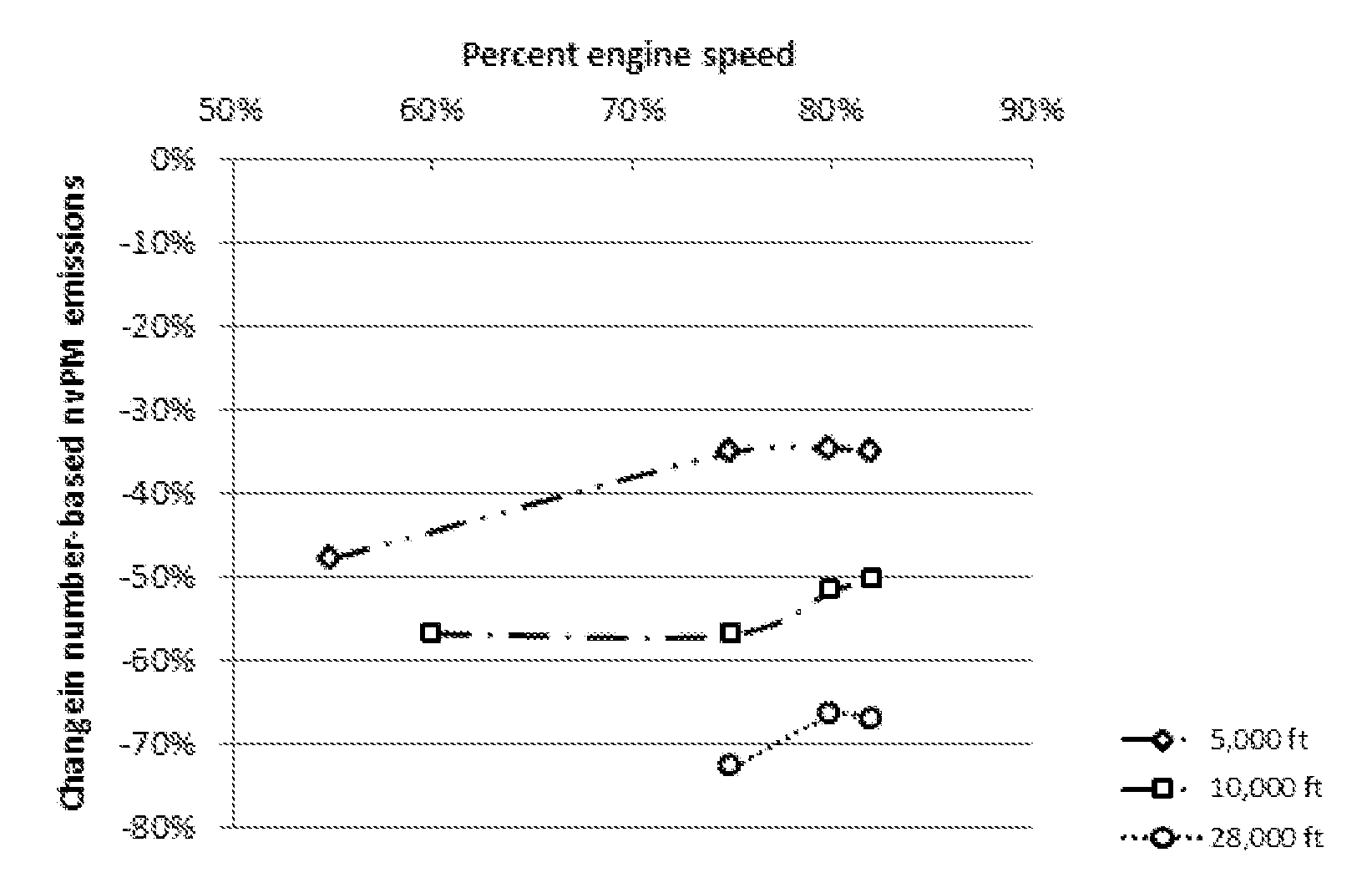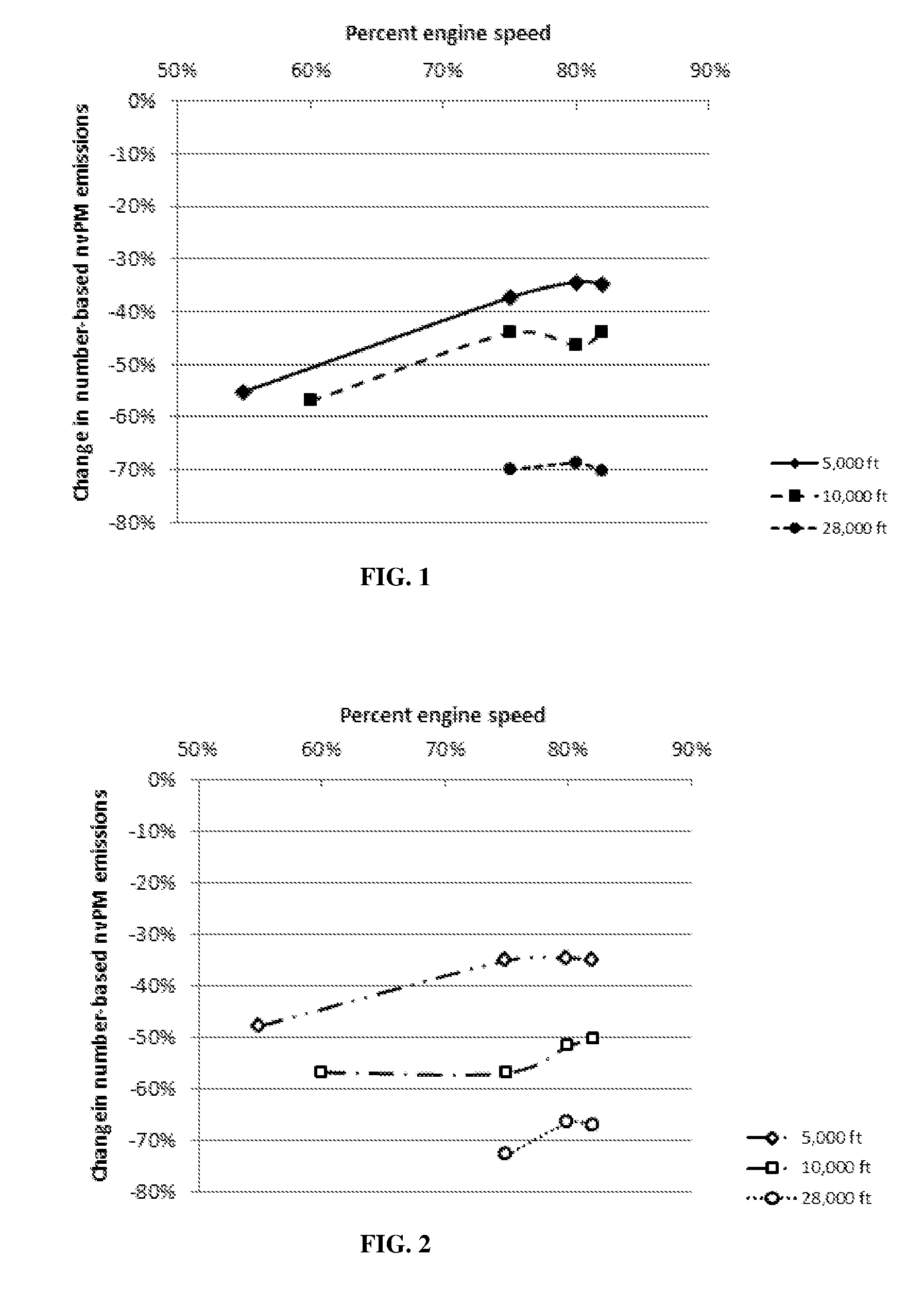Reduced emissions aromatics-containing jet fuels
a jet fuel and aromatic technology, applied in the direction of fuels, machines/engines, mechanical equipment, etc., can solve the problems of difficult to produce a low particulate emission jet fuel that contains the required amount of aromaticity, and achieve the effects of reducing particulate emissions, ensuring fuel compatibility, and minimizing environmental impa
- Summary
- Abstract
- Description
- Claims
- Application Information
AI Technical Summary
Benefits of technology
Problems solved by technology
Method used
Image
Examples
example 1
Production of Synthesized Aromatic Kerosene (SAK)
[0138]A three step catalytic bioreforming process utilizing hydrogenation, aqueous phase reforming and acid condensation was used to convert beet sugar to an aromatic-rich organic product. Hydrogenation was used to convert the beet sugar to a sugar alcohol feedstock, which was then converted to oxygenates using an APR deoxygenation catalyst. The resulting intermediate stream of oxygenates was then converted to the desired C4+ compounds using an acid condensation catalyst as the oxygenate conversion catalyst.
[0139]The hydrogenation catalyst was prepared with a ruthenium metal loading on a carbon support. The APR deoxygenation catalyst was prepared with a platinum and palladium metal loading on a zirconia support. The AC oxygenate conversion catalyst was prepared with a nickel metal loading on a ZSM-5 zeolite support.
[0140]The catalysts were loaded into separate fixed-bed, tubular reactors that were configured in series such that the li...
example 2
Production of SAK Using Lignocellulosic Feedstocks
[0146]A corn stover biomass material deconstructed using a dilute acid enzyme treatment, a common technique used to solubilize sugars from cellulose and hemicellulose while also solubilizing a portion of lignin as well, was used to produce an SAK jet fuel component. Prior to its use, the original hydrolysate was filtered to remove particulates, ion exchanged to remove a majority of ash contaminants, and dewatered to concentrate the carbon containing fraction to 60% by weight, with the balance being water.
[0147]A two-step catalytic process utilizing aqueous phase reforming and acid condensation was used to convert the hydrolysate to an aromatic-rich organic product. The APR deoxygenation catalyst was prepared to include palladium, molybdenum and tin on a zirconia support. The AC catalyst was prepared with a nickel metal loading on a ZSM-5 zeolite support.
[0148]Thee catalysts were loaded into separate fixed-bed, tubular reactors that w...
example 3
nvPM Number and Mass Emissions and NOx Emissions Measured from Comparative Example A and Jet Fuel Blends
[0150]Comparative Example A and various jet fuel blends were combusted in a Microturbo TRS-18 turbojet engine under simulated altitude atmospheric temperature and pressure conditions. nvPM number and mass emissions were measured using an Aerospace Information Report (AIR) 6241 compliant system as specified by the Society of Automotive Engineers (SAE) Aircraft Exhaust Emissions Measurement Committee (E-31) for the measurement of non-volatile particulate matter (nvPM) from gas turbine engines (Reference: SAE Aerospace Information Report (AIR) 6241. Procedure for the Continuous Sampling and Measurement of Non-Volatile Particle Emissions from Aircraft Turbine Engines, 2013, SAE International, Warrendale, Pa. Nitrogen oxides (NOx) measurements were made using a SEMTECH-DS non-dispersive ultraviolet absorption instrument. The concentrations were converted to emission indices using the p...
PUM
| Property | Measurement | Unit |
|---|---|---|
| density | aaaaa | aaaaa |
| boiling point | aaaaa | aaaaa |
| boiling point | aaaaa | aaaaa |
Abstract
Description
Claims
Application Information
 Login to View More
Login to View More - R&D
- Intellectual Property
- Life Sciences
- Materials
- Tech Scout
- Unparalleled Data Quality
- Higher Quality Content
- 60% Fewer Hallucinations
Browse by: Latest US Patents, China's latest patents, Technical Efficacy Thesaurus, Application Domain, Technology Topic, Popular Technical Reports.
© 2025 PatSnap. All rights reserved.Legal|Privacy policy|Modern Slavery Act Transparency Statement|Sitemap|About US| Contact US: help@patsnap.com



